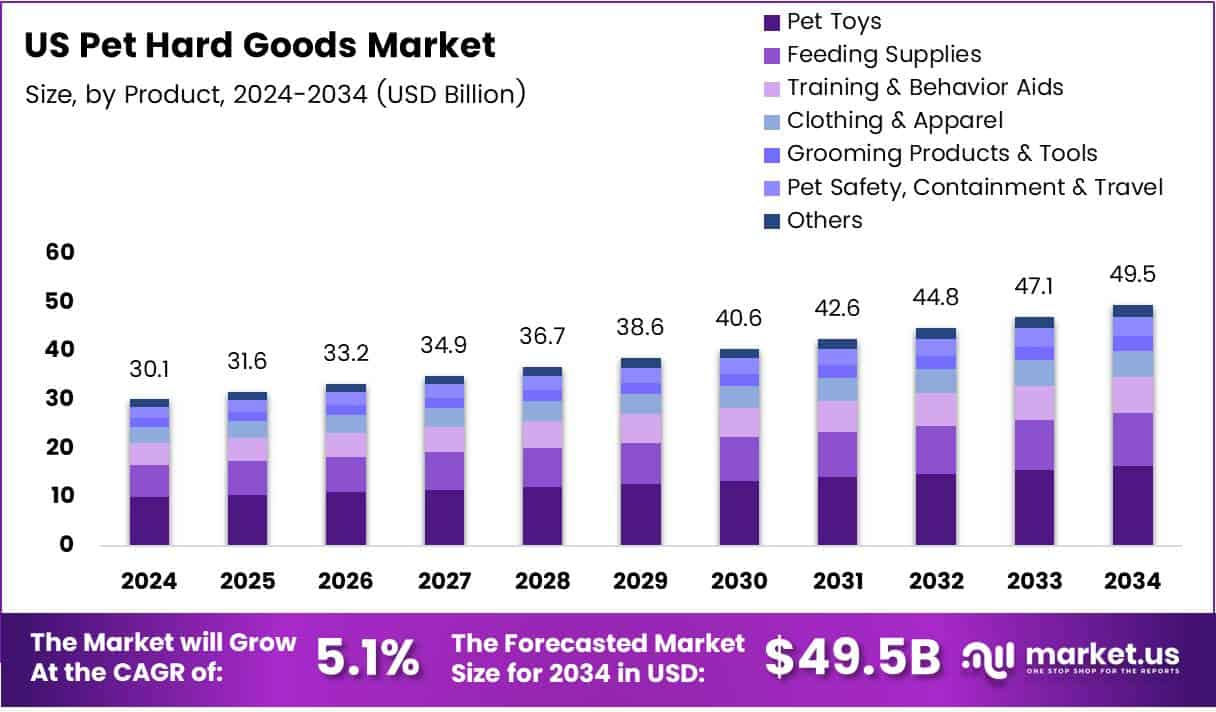Table of Contents
Market Overview
The U.S. Pet Hard Goods Market is projected to reach USD 49.5 billion by 2034, up from USD 30.1 billion in 2024, growing at a compound annual growth rate (CAGR) of 5.1% during the forecast period from 2025 to 2034. This growth is driven by increasing pet ownership, rising consumer spending on pet wellness, and the humanization of pets.
Opportunities abound in the market, particularly in innovative product categories. Smart feeders, GPS collars, and ergonomic bedding are gaining traction. Additionally, consumer preferences for eco-friendly and sustainable products are creating niches for manufacturers and retailers willing to adapt their materials and practices.
Government regulations, particularly those focused on animal welfare, indirectly benefit the hard goods segment. Safety standards and product labeling requirements push brands to invest in quality, which enhances consumer trust.
State-level funding and incentives for pet adoption and welfare facilities may also stimulate hard goods demand. Increased funding for shelters often translates into bulk purchases of crates, bedding, and feeding systems, opening up B2B supply chain opportunities in the hard goods market.

Market Segmentation
By Product Type
- Pet Toys: Leading the market with a 30.5% share in 2024, pet toys are popular due to their role in providing mental stimulation and physical exercise for pets.
- Feeding Supplies: Including bowls, feeders, and water dispensers, this segment is essential for daily pet care.
- Training & Behavior Aids: Products like clickers, training collars, and behavior correction tools are vital for pet training.
- Clothing & Apparel: Pet clothing, including coats and sweaters, is gaining popularity, especially in colder regions.
- Grooming Products & Tools: Comprising brushes, combs, nail clippers, and shampoos, this segment supports pet hygiene.
- Pet Safety, Containment & Travel: Includes crates, carriers, and safety harnesses, ensuring pet safety during travel.
- Aquarium & Terrarium Supplies: Catering to aquatic and reptile pet owners, this segment includes tanks, filters, and accessories.
- Collars, Leashes & Harnesses: Essential for walking and controlling pets, this segment remains a staple in pet hard goods.
- Bedding & Furniture: Beds, cushions, and furniture designed for pets’ comfort.
- Cleaning & Waste Management: Products like litter boxes, waste bags, and cleaning sprays are crucial for maintaining cleanliness.
By Distribution Channel
- Store-driven/Brick-and-Mortar: Dominating the market with an 81.6% share in 2024, physical retail stores remain the preferred shopping method for pet owners due to the tactile experience and immediate product availability.
- Online: E-commerce platforms are growing rapidly, offering convenience and a wide range of products.
Market Drivers
- Increasing Pet Ownership: With 66% of U.S. households owning pets in 2024, the demand for pet products continues to rise.
- Humanization of Pets: Pet owners are increasingly treating pets as family members, leading to higher spending on premium pet products.
- Awareness of Pet Wellness: Growing awareness about pet health and well-being is driving demand for quality pet products.
- Product Innovation: Manufacturers are introducing innovative products, such as interactive toys and ergonomic furniture, to meet evolving consumer preferences.
Competitive Landscape
The U.S. Pet Hard Goods Market is characterized by the presence of numerous players offering a wide range of products. Key companies include major retailers like Petco, PetSmart, Chewy, and Amazon, among others. These companies compete based on product quality, price, brand reputation, and customer service. Private label brands are also gaining traction, offering cost-effective alternatives to branded products.
Future Outlook
The U.S. Pet Hard Goods Market is expected to continue its growth trajectory, driven by the factors mentioned above. E-commerce is anticipated to play a significant role in this growth, with more pet owners opting for the convenience of online shopping. Additionally, the trend toward premium and specialized pet products is likely to persist, as pet owners seek products that cater to their pets’ specific needs.
Recent Developments
- In July 2025, Polish biotech startup Proteine Resources raised €9.5 million (US$10.2 million) from the EIC Accelerator to build the first fully autonomous insect protein facility and develop a beef alternative for pet food.
- In January 2025, the Pet Food Institute received $1.65 million under the USDA promotion program to boost pet food competitiveness in global markets.
- In December 2024, Healthybud closed a $1.5 million strategic funding round to expand its superfood pet wellness product range.
- In June 2025, Partners Group acquired MPM Products, a global pet food business, to expand its presence in the pet food industry.
Conclusion
The U.S. Pet Hard Goods Market presents significant opportunities for manufacturers and retailers. Understanding consumer preferences, focusing on product innovation, and leveraging both online and offline distribution channels will be key to capitalizing on this growing market. As pet ownership continues to rise and the humanization of pets becomes more pronounced, the demand for high-quality pet products is expected to remain strong.
Take advantage of our unbeatable offer - buy now!

Discuss your needs with our analyst
Please share your requirements with more details so our analyst can check if they can solve your problem(s)



